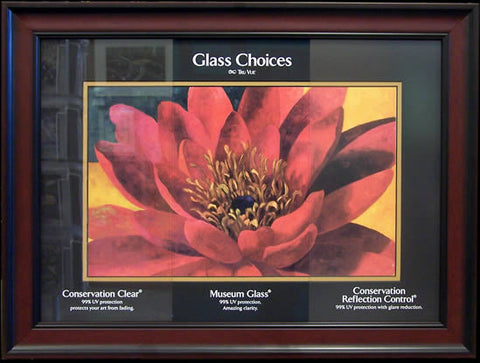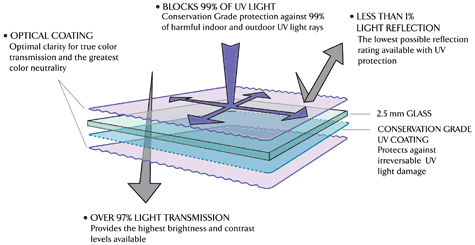Glass
For maximum print longevity, it is extremely important to display your print under some type of glazing, either glass or Plexiglas (Acrylic). Glazing protects the print from harmful UV wavelengths which tend to fade prints more quickly. It also protects the print from fingerprints, smoke, cooking fumes and other contaminants.
We provide regular glass, UV glass, non-glare glass, Plexiglass, museum glass for option.
Standard Glazing Options - Glass
Museum Glass (Best)

True Vue Museum glass is highest quality glass available today for framing. It is a crystal clear, UV-filtering glass that has been treated with an anti-reflective coating, similar to what is used on modern camera lenses. The coating dramatically reduces reflections and glare, making it virtually invisible. If you've ever seen a framed picture that had glass so clear and glare-free that you had to touch it to make sure it was there, then you've seen museum glass.

* Reduces reflection by over 85% (to less than 1% of total light), the lowest possible reflection rating available with UV protection
* Provides the highest brightness and contrast levels available
* Optimal clarity for true color transmission
* Greatest color neutrality * Protect works of art against 99% of harmful indoor and outdoor UV light rays
Standard Glazing Options - Plexiglas®
- Plexiglas®, offers greater versatility and protection than glass. Up to 17 times stronger and less than half the weight of an equivalent piece of glass, allow for lower shipping costs and less breakage. Standard and Non-Glare options include outstanding optical quality, up to 99% ultraviolet filtering, better breakage resistance and 50% weight reduction.
Our Recommendation
Some general rules of thumb for selecting a glazing option:Use Museum Glass when:
- You don't need to ship the framed art
- The framed art is not excessively large (weight is not a problem)
- You want the best possible presentation of the image
- It fits within your budget
Use UV Glass when:
- You don't need to ship the framed art
- The framed art is not excessively large
- Your lighting system produces good control over reflections
- Museum Glass is too costly for your budget
Use Non-glare Glass when:
- Non-glare glass is a cost-effective way to reduce the reflections caused by clear glass. This type of glass has a significantly reduced reflection. By applying an acid coating to the glass, it is able to scatter the reflections and carry the non-glare title. One of the disadvantages I to non-glare glass, is that there is a little fuzziness to it.
- Non-glare glass also gives artwork a softer look, which works wen for some types of art, including watercolors and landscapes. Non-glare glass is also effective with softer prints.
Use PLEXIGLASS when:
- You need to ship the framed art
- The art is oversized (above 30"x40")
- You want the best possible presentation of the image
- You will be careful when cleaning it in order to avoid scratches
- It fits within your budget (Museum acrylic is currently very expensive)
